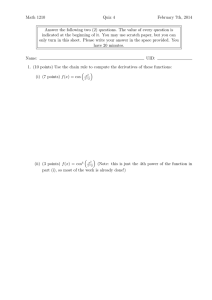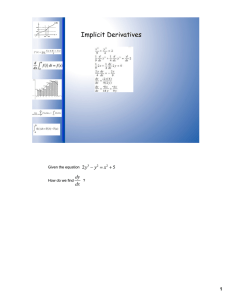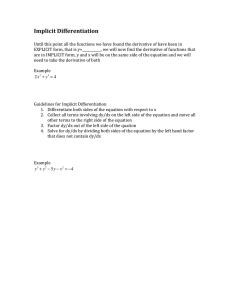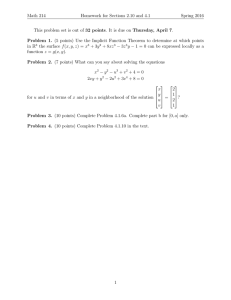Optimization and the Implicit Function Theorems
advertisement
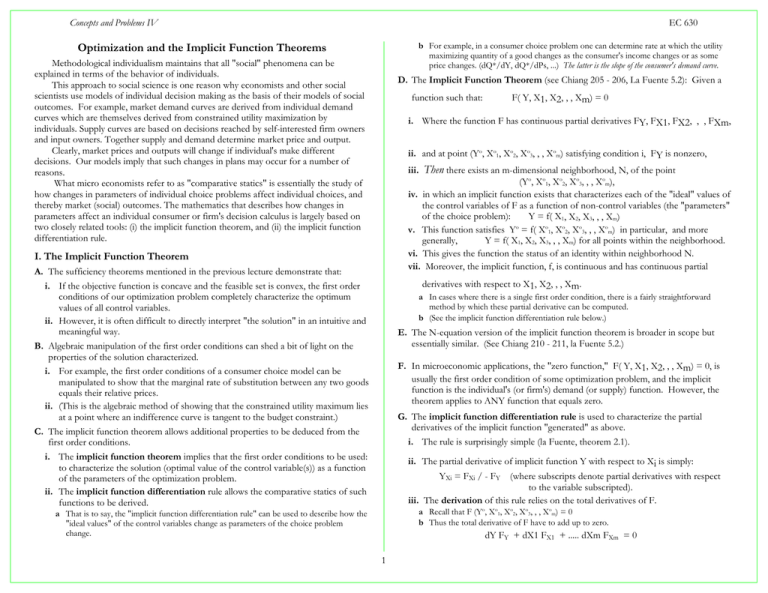
Concepts and Problems IV EC 630 Optimization and the Implicit Function Theorems b For example, in a consumer choice problem one can determine rate at which the utility maximizing quantity of a good changes as the consumer's income changes or as some price changes. (dQ*/dY, dQ*/dPs, ...) The latter is the slope of the consumer's demand curve. Methodological individualism maintains that all "social" phenomena can be explained in terms of the behavior of individuals. This approach to social science is one reason why economists and other social scientists use models of individual decision making as the basis of their models of social outcomes. For example, market demand curves are derived from individual demand curves which are themselves derived from constrained utility maximization by individuals. Supply curves are based on decisions reached by self-interested firm owners and input owners. Together supply and demand determine market price and output. Clearly, market prices and outputs will change if individual's make different decisions. Our models imply that such changes in plans may occur for a number of reasons. What micro economists refer to as "comparative statics" is essentially the study of how changes in parameters of individual choice problems affect individual choices, and thereby market (social) outcomes. The mathematics that describes how changes in parameters affect an individual consumer or firm's decision calculus is largely based on two closely related tools: (i) the implicit function theorem, and (ii) the implicit function differentiation rule. D. The Implicit Function Theorem (see Chiang 205 - 206, La Fuente 5.2): Given a F( Y, X1, X2, , , Xm) = 0 function such that: i. Where the function F has continuous partial derivatives FY, FX1, FX2, , , FXm, ii. and at point (Yo, Xo1, Xo2, Xo3, , , Xom) satisfying condition i, FY is nonzero, iii. Then there exists an m-dimensional neighborhood, N, of the point (Yo, Xo1, Xo2, Xo3, , , Xom), iv. in which an implicit function exists that characterizes each of the "ideal" values of the control variables of F as a function of non-control variables (the "parameters" of the choice problem): Y = f( X1, X2, X3, , , Xm) o v. This function satisfies Y = f( Xo1, Xo2, Xo3, , , Xom) in particular, and more generally, Y = f( X1, X2, X3, , , Xm) for all points within the neighborhood. vi. This gives the function the status of an identity within neighborhood N. vii. Moreover, the implicit function, f, is continuous and has continuous partial I. The Implicit Function Theorem A. The sufficiency theorems mentioned in the previous lecture demonstrate that: i. If the objective function is concave and the feasible set is convex, the first order conditions of our optimization problem completely characterize the optimum values of all control variables. ii. However, it is often difficult to directly interpret "the solution" in an intuitive and meaningful way. B. Algebraic manipulation of the first order conditions can shed a bit of light on the properties of the solution characterized. i. For example, the first order conditions of a consumer choice model can be manipulated to show that the marginal rate of substitution between any two goods equals their relative prices. ii. (This is the algebraic method of showing that the constrained utility maximum lies at a point where an indifference curve is tangent to the budget constraint.) C. The implicit function theorem allows additional properties to be deduced from the first order conditions. i. The implicit function theorem implies that the first order conditions to be used: to characterize the solution (optimal value of the control variable(s)) as a function of the parameters of the optimization problem. ii. The implicit function differentiation rule allows the comparative statics of such functions to be derived. derivatives with respect to X1, X2, , , Xm. a In cases where there is a single first order condition, there is a fairly straightforward method by which these partial derivative can be computed. b (See the implicit function differentiation rule below.) E. The N-equation version of the implicit function theorem is broader in scope but essentially similar. (See Chiang 210 - 211, la Fuente 5.2.) F. In microeconomic applications, the "zero function," F( Y, X1, X2, , , Xm) = 0, is usually the first order condition of some optimization problem, and the implicit function is the individual's (or firm's) demand (or supply) function. However, the theorem applies to ANY function that equals zero. G. The implicit function differentiation rule is used to characterize the partial derivatives of the implicit function "generated" as above. i. The rule is surprisingly simple (la Fuente, theorem 2.1). ii. The partial derivative of implicit function Y with respect to Xi is simply: YXi = FXi / - FY (where subscripts denote partial derivatives with respect to the variable subscripted). iii. The derivation of this rule relies on the total derivatives of F. a Recall that F (Yo, Xo1, Xo2, Xo3, , , Xom) = 0 b Thus the total derivative of F have to add up to zero. a That is to say, the "implicit function differentiation rule" can be used to describe how the "ideal values" of the control variables change as parameters of the choice problem change. dY FY + dX1 FX1 + ..... dXm FXm = 0 1 Concepts and Problems IV EC 630 c Consequently, if we allow only Xi and Y to vary, ix. The "sign" of this derivative of our implicit function tells us whether Al's demand curve slopes downward or not. x. The "sign" is jointly determined by all the partial derivatives in the expression above. Most of these have already been characterized by our assumptions about Al's utility function and his budget constraint. dYFY + dXi FXi = 0 d Solving this expression for dY/dXi yields: dY/dXi = FXi / - FY a From the original characterization of U we know that all of the first partial derivatives are positive b We also know that all of the second derivatives are negative (This implies that both X1 and X2 are goods that exhibit diminishing marginal utility.). c We also know that the cross partial is positive (an increase in good 2 increases the marginal utility of good 1). d Together these characteristics of U imply that Al's demand curve is downward sloping, X1* P1< 0. e (As an exercise, compute the derivative of the demand function with respect to Al's wealth and see whether "positive cross partials" also rule out inferior goods.) iv. The implicit function differentiation rule allows one to characterize how the solution to an optimization problem varies as parameters of the problem vary. H. Example: Properties of an individual's demand function i. Suppose that "Al" has a utility function, U = u( X1, X2) which is monotone increasing in X1 and X2, twice differentiable and strictly concave. The latter may be assured by assuming that: UX1 X2 ≥ 0, UX1 X1 < 0, and UX2 X2 < 0. I. An alternative of obtaining this result is to substitute the optimized value of the control variable (as a function) into the first order condition, and then differentiate with respect to the parameter of interest. i. The result will include the derivative of interest, here X1* PI along with a number of other derivatives. ii. The next step is to algebraically isolate the derivative of interest. (X1* PI = ???) iii. The result will be mathematically equivalent to that obtained via the implicit function theorem. ii. Al wants to find the utility maximizing combination of X1 and X2 given the budget constraint that he faces, W = P1X1 + P2 X2 . iii. Using the substitution method: U = u( X1, (W - P1X1)/P2 ) iv. Differentiating with respect to X1 yields: UX1 + UX2 ( - P1/P2) = 0 a The value of X1 that satisfies this first order condition will maximize utility. b Denote such that value of X1 as X1* v. Note that at X1*, the first order condition is a function like F in the definition of the implicit function theorem; that is to say, the "foc" always equals zero at X1*. Since the first order condition is differentiable (remember that we assumed that U was twice differentiable), an implicit function exists that characterizes X1* as a function of the other parameters of the choice problem. II. Problem Set (Collected next week) A. Determine the first order conditions that characterize each of the following firm's profit maximizing level of output, Q*, in the market setting characterized. Each firm produces its output at cost C and sells its output at price P: i. C = w(Q2 + 1) where P = Po ("w" is the wage rate) ii. C = c(Q, w, r) where P = Po (Cost function c is monotone increasing and strictly convex, e.g. has positive second derivatives. "r" is the rental cost of capital.) iii. C = c(Q,w, r) and P = p(Q,Y) ( The cost function, c, is as before, and inverse demand function p is decreasing in Q and increasing in consumer income Y.) B. Use the implicit function theorem on your answers to part A to: i. write the ideal levels of output as a function of parameters of each firm's choice problem. ii. obtain derivatives of profit maximizing output levels with respect to wage rate w. iii. What, if anything, do your answers to part Bii imply about the short run effect of new labor laws that increase wage rates in the industry of interest? X1* = x( W, P1, P2) vi. Economists refer to this function as Al's demand function for X1. vii. The effect of a change in the price of good , P1,1 on Al's demand for good 1 can be characterized using the implicit function differentiation rule: a X1* P1 = FP1/ - FX1 b Given our first order condition in equation iv above, FP1/ - FX1 can be written as: [ UX1X2 (-X1/P2) + UX2( - 1/P2) - UX2X2 (P1/P2)(-X1/P2) ] ---------------------------------------------------------------------------------------------------------2 -[UX1X1 + 2 UX1X2 (-P1/P2) + UX2X2 (-P1/P2) ] Next Week: More on the implicit function theorem, the envelop theorem, and an introduction to time and uncertainty in economic decision making. viii. This expression is determined by carefully calculating the derivatives of the foc, UX1 + UX2 ( - P1/P2) , with respect to P1 and X1. 2
